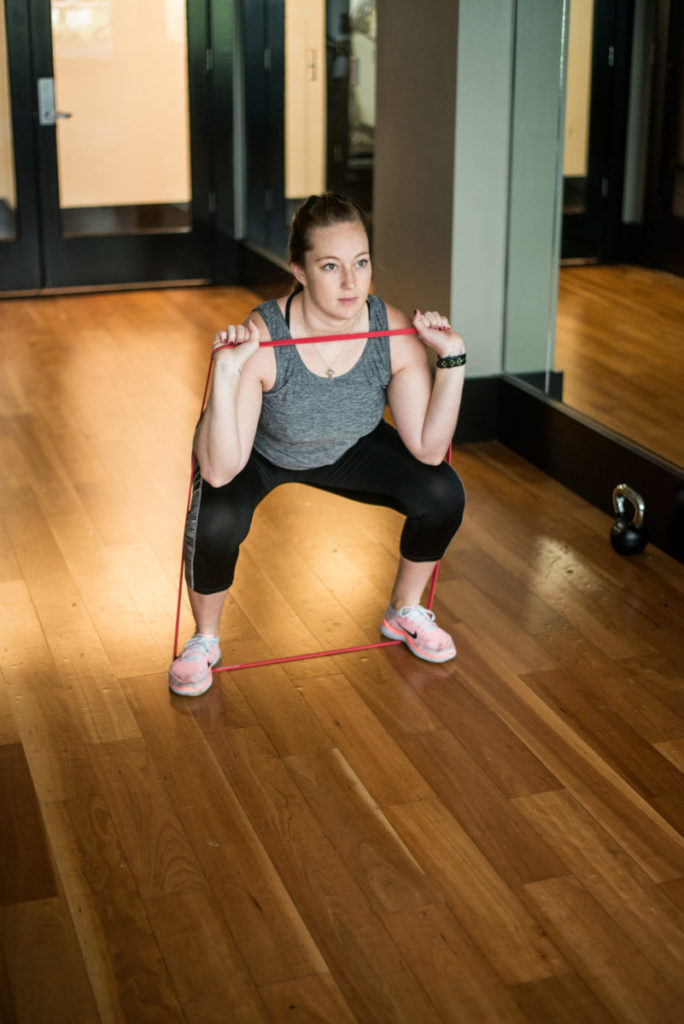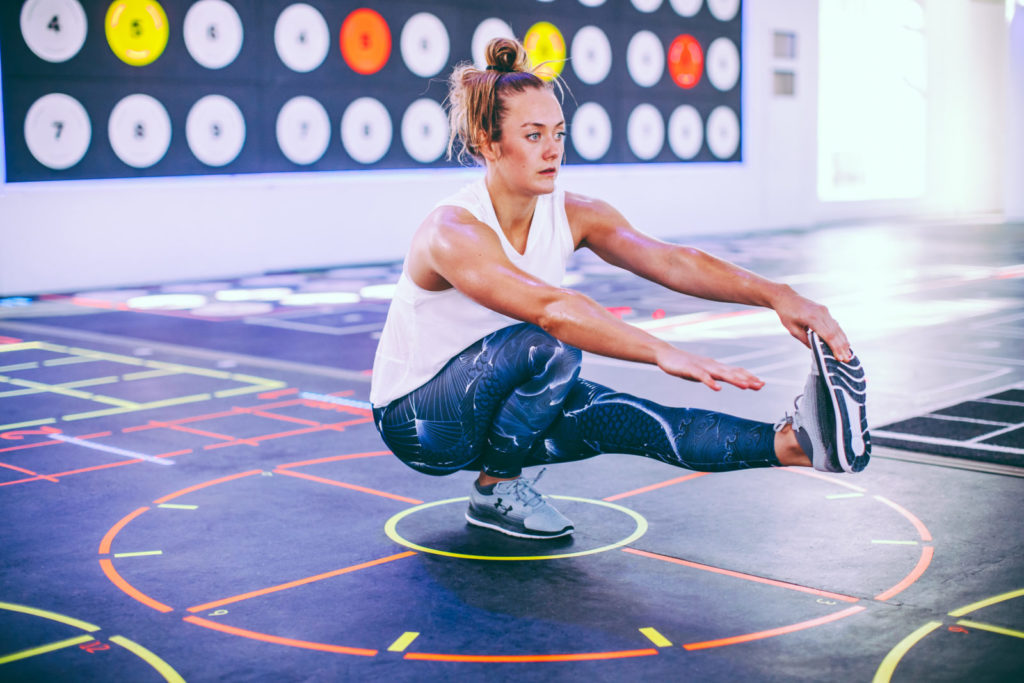When we run, each leg falls from the sky absorbing all of our body weight before we bound off the earth once again on a single foot. And we do this up to 2,000 times per mile! Running places extraordinary demands on our legs and requires power. It also demands resilience from connective tissue, ligaments, and muscles. I know most runners don’t like strength training, maybe even avoid it, but it is essential for performance and longevity in the sport – recreational or otherwise. I’ve detailed three exercises in this post that will improve your running performance and help keep your legs free of injury.

1. Resistance Band Overhead Squat
This is a challenging but highly effective exercise for increasing mobility, flexibility, and core strength while improving power in your quads and glutes. As opposed to supporting a weighted bar across your back, you hold the resistance band overhead while performing squats. Yes, it is a challenging and dynamic movement and it can create a lot of value per rep. You are also far less likely to tweak your lower back or any other part of your body doing this movement as opposed to a standard weighted back squat.
Equipment: Resistance bands come in a variety of widths and the wider the band, the greater the resistance. If you’re new to this exercise, I recommend beginning with a skinny band to get used to the movement and perform it correctly.
Form: Start out by slipping the resistance band under you feet and raise up to your shoulders with palms facing forward. Get yourself settled into a good position with your feet shoulder width apart and your toes pointing slightly out. Once you’re set, raise the band overhead and then lower yourself slowly into a squat keeping your back as flat as possible. The movement will be a bit awkward at first and you’ll notice right away if you’re lacking flexibility throughout your shoulders and upper back. Don’t let that stop you. Working through this range of motion will help to improve the mobility in those areas of your body that are too tight.
Sets and Reps: Start out with a light resistance band for three sets of 10 – 12 reps.
RELATED STORY:
Resistance Band Exercises for Runners

2. Single-Leg Pistol Squat
As a body weight only exercise, the single-leg pistol squat feels more strenuous to me than any barbell/dumbbell weighted lower body exercise. Ok, a 300 lb deadlift is a more intense movement for me, however, I don’t feel like I’m going to fail to get that weight off the ground. With a single leg pistol squat, each rep is an adventure in defying gravity as I wobble and move my arms about for balance throughout the movement. Sometimes, I have to put the other foot down to get back up into standing position. And the challenge I’m describing here is the beauty of this exercise.
As runners, we need to challenge our balance within resistance training workouts because that kind of stress effectively strengthens our connective tissue and ligaments in the feet, ankles, and through the knees. The single-leg squat also addresses leg dominance. I’ve found this to be the best movement for me to create a greater balance of strength between my dominant right leg and non-dominant left.
Equipment: Please ignore the amazing female athlete in the above picture and use a flat bench to sit back on when starting out with this exercise. Take a flat bench from the dumbbell area or wherever you see one sitting idle in your gym and find a space to set yourself up.
Form: Before you start, line up in front of the bench and practice sitting down to make sure you’re positioned correctly. You don’t want to be too close to the bench, just close enough to catch a seat should you lose your balance sitting back. For most, it’s necessary to squat down to the bench, sit for a quick moment, and then rise up. To get started, square your shoulders, keep your back flat, kick one leg out slightly and hold it above the ground, extend both arms forward for balance and begin to lower your rear to the bench. Try touching the bench softly before standing back up. Again, if you have to sit down before rising again, that is a totally acceptable way to get started with this movement.
Sets and Reps: If you’re new to this exercise, it’s best to start with lower reps until your form is tight. So, begin with 6 reps for each leg and build slowly to 10 reps over several weeks.
RELATED STORY:
3. Box Step Ups
The box step up started out as one of my go-to exercises in preparation for backpacking and mountain climbing trips. Long, slow endurance runs are also always part of that training work too. As I combined the two, I found that my running, especially on the trail, improved in direct relationship with the amount of box step work I perform. The work load in this exercise will enhance your strength and stamina in the hills.
To gain the greatest benefit, hold a light dumbbell in each hand. The loading will create greater engagement of the glutes and hamstrings. It will also effectively work your balance, ankle stability, and leg dominance.
Equipment: A wooden or metal plyometric box that is about knee height – 12″ to 18.” Dumbbells or kettlebells from 10-30 lbs.
Form: With dumbbells or kettlebells in hand, face the plyo box squarely, lift one leg, plant your foot flat onto the top of the box and rise up using the strength of the raised leg only. Do your best to not push off the ground with your other foot. While rising up, drive the rear leg forward and bring that knee up to waist level as if you’re kneeing a soccer ball forward. The next phase of the movement, lowering down from the box, is really important to do correctly to gain the most value.
Once your knee drive is at waist level, bring that leg down slowly toward the platform. If you need to tap your toe onto the platform for balance after the knee drive, that’s ok. Once stable, begin to lower yourself slowly and land softly back to the floor. Emphasize the eccentric movement by lowering yourself for a count of two. Once both feet are planted on the floor, begin again by alternating to the other leg to step up.
Sets and Reps: Start out with two sets of 20 reps (10 each leg) with dumbbells/kettelbells light enough to perform the movement correctly through all reps.
RELATED STORY:
10 Essential Strength Movement for Preventing Injury
Feature Photo by Brian Metzler

